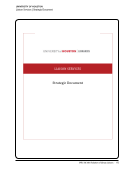144 · Representative Documents: Responsibilities, Competencies, Goals
UNIVERSITY OF ILLINOIS AT CHICAGO
UIC Library Liaison Program: Activities, Competencies, and Indicators
5 |UIC Library Liaison Activities, Competencies, and Indicators, July 2015
in the late nineteenth and early twentieth century for health sciences, we hold
rare and historical works on women's health, particularly pregnancy,
childbirth, surgery, and fertility).
o Be able to explain use of SCUA discovery tools such as finding aids to
instructional faculty and students.
o Incorporate discussion of SCUA as part of bibliographic instruction on primary
source research.
Government Information
o Government structures/levels, processes and administrative structures and
their profound influence on the bibliographic control of government
information. Government information is often based on long-term programs over
several decades and different political elections. Much of this depends on earlier
decisions or analysis that may or may not be directly mentioned or referred to. Very
often several/many years of these types of documents have to be found or read for
the user to understand the context of the question or government information that
they seek.
o Understanding legislation, regulations, legal decisions, and public statements.
Understand, and be able to explain to the user, how the basic laws are created,
implemented and adjudicated and how this process determines where the
information can be found.
o Government data sources and reports. Government data can be raw, analyzed to
a limited degree or fully explained. There is no single place to look for government
data or reports. However, there are several critical web pages and data depository
sites one can consult.
o Understand the “gray literature”: a shared information world between public
and private organizations. Over the last 35 years, non-government special interest
groups, political parties, professional associations, and other non-government
organizations have produced or co-created government information. They may not
necessarily be issued by a government agency, but they are often distributed
through government information programs.
o Understand when to use “digital” government information and services. For
the last ten years, many e-government processes and services are integrating more
public information sources with deeply complicated government processes and
services directed at the individual citizen. This includes regulatory, financial,
statistical and environmental information. Very often these information sources are
only available through stand-alone databases, or digital record keeping, managed by
a particular government agency or contractor.
o Understand the history and organization of government information
collections at UIC:
The Paper Universe
The Gray Literature Universe
The Digital Universe
o Learn how to answer reference questions with possible government
information resources.
UNIVERSITY OF ILLINOIS AT CHICAGO
UIC Library Liaison Program: Activities, Competencies, and Indicators
5 |UIC Library Liaison Activities, Competencies, and Indicators, July 2015
in the late nineteenth and early twentieth century for health sciences, we hold
rare and historical works on women's health, particularly pregnancy,
childbirth, surgery, and fertility).
o Be able to explain use of SCUA discovery tools such as finding aids to
instructional faculty and students.
o Incorporate discussion of SCUA as part of bibliographic instruction on primary
source research.
Government Information
o Government structures/levels, processes and administrative structures and
their profound influence on the bibliographic control of government
information. Government information is often based on long-term programs over
several decades and different political elections. Much of this depends on earlier
decisions or analysis that may or may not be directly mentioned or referred to. Very
often several/many years of these types of documents have to be found or read for
the user to understand the context of the question or government information that
they seek.
o Understanding legislation, regulations, legal decisions, and public statements.
Understand, and be able to explain to the user, how the basic laws are created,
implemented and adjudicated and how this process determines where the
information can be found.
o Government data sources and reports. Government data can be raw, analyzed to
a limited degree or fully explained. There is no single place to look for government
data or reports. However, there are several critical web pages and data depository
sites one can consult.
o Understand the “gray literature”: a shared information world between public
and private organizations. Over the last 35 years, non-government special interest
groups, political parties, professional associations, and other non-government
organizations have produced or co-created government information. They may not
necessarily be issued by a government agency, but they are often distributed
through government information programs.
o Understand when to use “digital” government information and services. For
the last ten years, many e-government processes and services are integrating more
public information sources with deeply complicated government processes and
services directed at the individual citizen. This includes regulatory, financial,
statistical and environmental information. Very often these information sources are
only available through stand-alone databases, or digital record keeping, managed by
a particular government agency or contractor.
o Understand the history and organization of government information
collections at UIC:
The Paper Universe
The Gray Literature Universe
The Digital Universe
o Learn how to answer reference questions with possible government
information resources.












































































































































































































